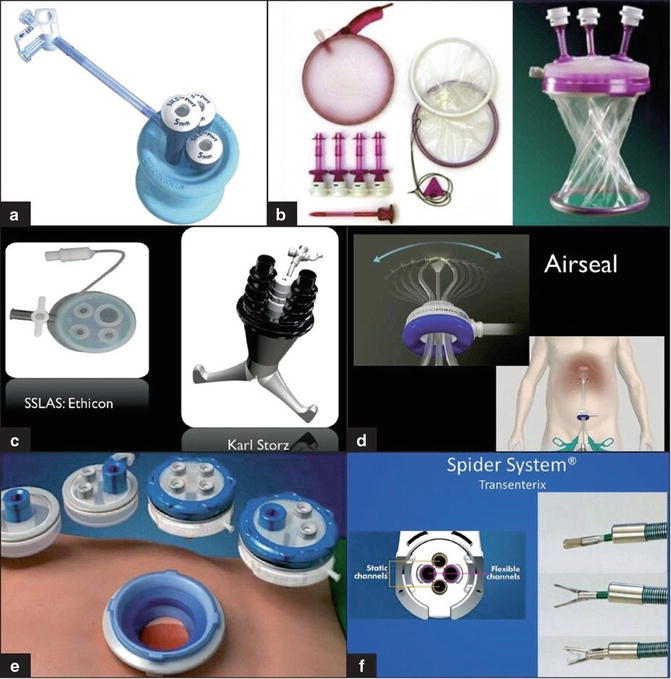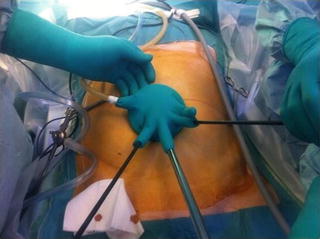SPA
Single-port access
SILS
Single-incision laparoscopic surgery
OPUS
One-port umbilical surgery
E-NOTES
Embryonic natural orifice transumbilical endoscopic surgery
SIMPLE
Single-incision multi-port laparo-endoscopic surgery
SPS
Single-port surgery
VSUS
Visibly scarless urological surgery
SIL
Single-incision laparoscopy
SPL
Single-port laparoscopy
R-NOTES
Robotic-assisted natural orifice transumbilical endoscopic surgery
U-NOTES
Umbilical natural orifice transluminal endoscopic surgery
LESS
Laparo-endoscopic single-site surgery
SLaPP
Single laparoscopic port procedure
NOTUS
Natural orifice transumbilical surgery
SLiPP
Single laparoscopic incision and port procedure
SILCS (single-incision laparoscopic colorectal surgery) represents a potential advance in minimally invasive approaches to colorectal disease. Although widely promoted, data for improved outcomes are virtually absent but preliminary data demonstrate that SILCS can be performed safely in selected patients by experienced surgeons [10]. The actual benefits of single incision compared with multiple-port laparoscopic colectomy are not immediately evident and may be beyond that of simple cosmetics. This will be discussed elsewhere in this textbook.
Despite the growing enthusiasm for SILCS, there are several challenges compared with standard multi-port laparoscopic colectomy. Handling straight instruments in parallel with the laparoscope through a small incision decreases the range of movement for the surgeon and complicates camera use by the assistant. These difficulties become evident during colorectal surgery because, unlike laparoscopic cholecystectomy or appendectomy, SILCS often requires operating in different abdominal quadrants. Furthermore, the learning curve of undetermined length still exists for multi-port laparoscopy and is more exhaustive than for other minimally invasive procedures.
Multi-port laparoscopic colectomy traditionally relies on the principles of triangulation and traction/counter-traction to facilitate the precise dissection of anatomical planes.11 These essential principles require significant modification to successfully perform single-port laparoscopic surgery. The cornerstone of SILCS is the utilization of a single port with 2–4 trocar place holders. Limitations of this approach include a confined working space, the crossing or clashing of instruments, off-field vision, and the intermittent loss of pneumoperitoneum. To overcome these barriers, surgeons and industry have worked together to improve the design of both access ports and instruments. These novel platforms and devices are the focus of this chapter. It should be emphasized that despite the technical adjustments required in SILCS, the intra-abdominal procedural steps match the standardized techniques of laparoscopic colectomy as discussed in subsequent chapters.
Laparoscopes
The choice of a laparoscope for single-incision laparoscopic colorectal surgery should be based on operator preference and clinical application. When deciding upon a camera system for SILCS the following attributes should be considered. A 5 mm diameter scope takes up less space inside the access port and leaves a 10–12 mm port free for larger instruments such as a reticulating endoscopic stapling device. Secondly, it is advisable to use a laparoscope with a cable connection on the posterior rather than lateral aspect allowing rotation without interfering with instruments. The problem of the lateral light cable of regular telescopes and the bulky camera heads clashing with the instruments can be done away with by the use of a telescope with a coaxial light cable. In addition, using an extra-long or bariatric laparoscope staggered with regular-sized instruments may allow the free movement of the camera head away from the surgeon’s hands. Some surgeons prefer the assistant to sit so that the assistant’s hands move in a different plane, reducing the external interference. Integrated digital cameras also minimize external bulk and give more space.
Manufacturers have now developed a full range of laparoscopes that include 5 and 10 mm versions with 0°, 30°, or 45° direction of views in standard and high definition (720p). The newest advancements of laparoscopes to facilitate SILCS are the deflecting or articulating scopes, such as the EndoEYE™ by Olympus (Fig. 1.1). These laparoscopes are equipped with an advanced flexible tip design that provides a 100° view in all directions that can be fixed at any angle with a toggle switch. These articulating scopes are ideal for SILCS as they eliminate the need to exchange 0° scopes with angled scopes. They can also eliminate the crossing interference with parallel instruments while still providing a head-on directional view. It must however be noted that use of this instrument has a learning curve. If an internally flexible scope is not available, then an externally flexible scope will at least remove the assistant’s hands from the surgeon’s field.


Fig. 1.1
A rigid laparoscope compared to an internally flexible scope
Access Ports
Regardless of which platform is used, most SILCS begin with a vertical midline incision at umbilicus for entry into the peritoneum. The midline linea-alba is void of muscles and vascular structures and therefore minimizes postoperative pain and the potential for inadvertent vascular injuries. It is our practice to use a vertical midline incision and sharp dissection to enter the peritoneum under direction vision with the use of S-retractors. Entry is confirmed with a blunt hemostat or finger to minimize the risk of injury to intra-abdominal organs and vessels. Depending on the particular procedure, point of entry anywhere in abdomen may be utilized with this technique. For example, if a protective stoma is planned, one should consider the stoma site for entry and extraction. The size of the particular incision is based on the specific device used. Most ports should utilize at least one 10–12 mm trocar and two to three 5 mm trocars with side ports for CO2 insufflation and smoke evacuation. There are several single-incision platforms at your disposal (Fig. 1.2) and four of them will be discussed in detail in this chapter. They all have similarities in function with only minor deviations.


Fig. 1.2
The available single-incision platforms: (a) SILS™ Port by Covidien; (b) GelPoint® by Applied medical; (c) SSLAS© by Ethicon; (d) XCONE® by Storz; (e) Airseal© by SurgiQuest; (f) SPIDER® by Spider surgery
When choosing a platform one should consider the following technical considerations:
1.
The ability to maintain a consistent seal and pneumoperitoneum
2.
Trocar size and instruments that will be utilized
3.
The proper spacing that will be required
4.
Size of the specimen and extraction site
Glove-Port Technique
The glove-port technique emerged as a means to perform single-incision laparoscopic surgery in a simple, low-cost, and easily reproducible manner. The access device was made by a standard wound protector (a small size or extra small size wound protector and a size 6, non-latex, sterile glove. The wound protector is introduced through the small umbilical incision. The surgical glove was fixed to the outer ring of the wound protector. Access ports are utilized through the glove’s finger tips (Fig. 1.3).










